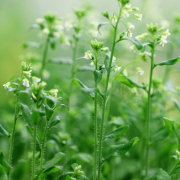In Plant Phys:
Tissue-specific silencing by miRNA* In Plant Physiology:
Tissue-specific silencing of Arabidopsis thaliana SUVH8 by miR171a star
Pablo Manavella, Daniel Koenig, Ignacio Rubio-Somoza, Hernán A Burbano, Claude Becker, and Detlef Weigel
MicroRNAs (miRNAs) are produced from double stranded precursors, from which a short duplex is excised. The strand of the duplex that remains more abundant is usually the active form, the miRNA, while steady-state levels of the other strand, the miRNA*, are generally lower. The executive engines of miRNA-directed gene silencing are RNA-induced silencing complexes (RISCs). During RISC maturation, the miRNA/miRNA* duplex associates with the catalytic subunit, an AGO protein. Subsequently, the guide strand, which directs gene silencing, is retained, while the passenger strand is degraded. Under certain circumstances, the miRNA*s can be retained as guide strands. MiR170 and miR171 are prototypical miRNAs in Arabidopsis thaliana, with well-defined targets. We found that the corresponding star molecules, the sequence-identical miR170* and miR171a* have several features of active miRNAs, such as sequence conservation and AGO1 association. We confirmed that active AGO1-miR171a* complexes are common in A. thaliana and that they trigger silencing of SUVH8, a new miR171a* target that was acquired very recently in the A. thaliana lineage. Our study demonstrates that each miR171a strand can be loaded onto RISC, with separate regulatory outcomes.



